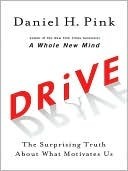More on this book
Community
Kindle Notes & Highlights
Read between
February 17 - July 12, 2020
“When money is used as an external reward for some activity, the subjects
lose intrinsic interest for the activity,” he wrote.5 Rewards can deliver a short-term boost—just as a jolt of caffeine can keep you cranking for a few more hours. But the effect wears off—and, worse, can reduce a person’s longer-term motivation to continue the project.
Humans are more than the sum of our biological urges. That first drive still mattered—no doubt about that—but it didn’t fully account for who we are.
previously unimagined “not only for profit” businesses
Economics, she explained, wasn’t the study of money. It was the study of behavior.
The best use of money as a motivator is to pay people enough to take the issue of money off the table.
“that Work consists of whatever a body is OBLIGED to do, and that Play consists of whatever a body is not obliged to do.”
Rewards, by their very nature, narrow our focus.
Another study of artists over a longer period shows that a concern for outside rewards might actually hinder eventual success.
Goals work. The academic literature shows that by helping us tune out distractions, goals can get us to try harder, work longer, and achieve more.
“Rather than being offered as an ‘over-the-counter’ salve for boosting performance, goal setting should be prescribed selectively, presented with a warning label, and closely monitored,” they
wrote.16 Goals that people set for themselves and that are devoted to attaining mastery are usually healthy. But goals imposed by others—sales targets, quarterly returns, standardized test scores, and so on—can sometimes have dangerous side effects.
The problem with making an extrinsic reward the only destination that matters is that some people will choose the quickest route there, even if it means taking the low road.
“Rewards are addictive in that once offered, a contingent reward makes an agent expect it whenever a similar task is faced, which in turn compels the principal to use rewards over and over again.”
In environments where extrinsic rewards are most salient, many people work only to the point that triggers the reward—and no further.
The starting point, of course, is to ensure that the baseline rewards—wages, salaries, benefits, and so on—are adequate and fair. Without a healthy baseline, motivation of any sort is difficult and often impossible.
The essential requirement: Any extrinsic reward should be unexpected and offered only after the task is complete.
First, consider nontangible rewards. Praise and positive feedback are much less corrosive than cash and trophies.
Many theories of behavior pivot around a particular human tendency: We’re keen responders to positive and negative reinforcements, or zippy calculators of our self-interest, or lumpy duffel bags of psychosexual conflicts. SDT, by contrast, begins with a notion of universal human needs. It argues that we have three innate psychological needs—competence, autonomy, and relatedness. When those needs are satisfied, we’re motivated, productive, and happy. When they’re thwarted, our motivation, productivity, and happiness plummet.
Human beings have an innate inner drive to be autonomous, self-determined, and connected to one another. And when that drive is liberated, people achieve more and live richer lives.
“The ultimate freedom for creative groups is the freedom to experiment with new ideas. Some skeptics insist that innovation is expensive. In the long run, innovation is cheap. Mediocrity is expensive—and autonomy can be the antidote.”
Type I behavior emerges when people have autonomy over the four T’s: their task, their time, their technique, and their team.
Control leads to compliance; autonomy leads to engagement. And this distinction leads to the second element of Type I behavior: mastery—the desire to get better and better at something that matters.
“The desire to do something because you find it deeply satisfying and personally challenging inspires the highest levels of creativity, whether it’s in the arts, sciences, or business.” TERESA AMABILE Professor, Harvard University
Dweck’s signature insight is that what people believe shapes what people achieve. Our beliefs about ourselves and the nature of our abilities—what she calls our “self-theories”—determine how we interpret our experiences and can set the boundaries on what we accomplish.
“Figure out for yourself what you want to be really good at, know that you’ll never really satisfy yourself that you’ve made it, and accept that that’s okay.” ROBERT B. REICH Former U.S. Secretary of Labor
validation from others, but when we’re listening to our own voice—doing something that matters, doing it well, and doing it in the service of a cause larger than ourselves.


